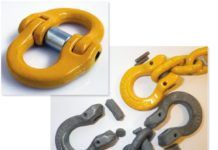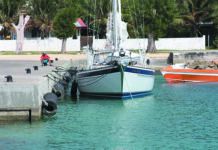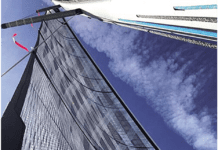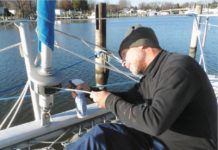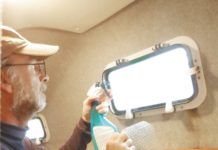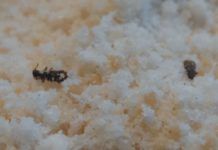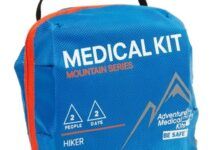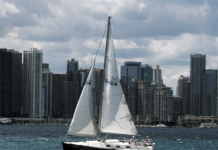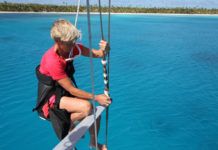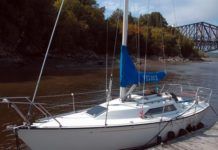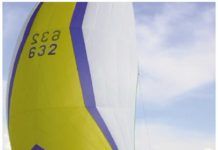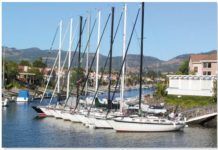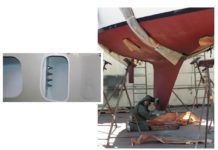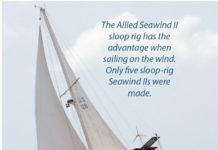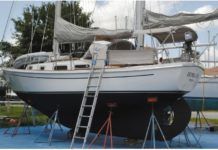Dragonfly 800
The Dragonfly 800 comes in two configurations, one for racing and one for what the company calls cruising, which is a misnomer only in that it implies a plodding demeanor, which is hardly the case. The essential difference is a taller mast and Kevlar sails for the racing model.
EXPO Solar Sailer
The EXPO Solar Sailer was conceived by Hoyt (who has a long list of conceptions to his credit), designed by Hood (who needs no introduction) and built by TPI(at present, or one time or another, the builder of J Boats, Aldens, Jeanneau catamarans and Freedoms). Put Gary Hoyt, Ted Hood and Everett Pearson in a canoe and you have the marine industry's maximum tripartite brain power. The cerebral sparks from these three New England dynamos produced the EXPO Solar Sailer.
Island Trader 37/38
In profile, the Island Trader 37 looks like she caught a wave on the chin. The sheer seems exaggerated, rising too high in the bow and stern. The low-aspect rig is short, carrying just 567 square feet of sail on a 30' 4" waterline. Displacement is reported anywhere from 18,600 lbs. to 26,400 Lbs. This gives the 37 an incredible displacement/length ratio of 422, and an abominable sail area/displacement ratio of 10.7, easily putting it in the "heavy" or "motorsailer" category.
Tripp 26
This 26-footer is totally unlike familiar racer/cruisers from Pearson, Catalina or Hunter. For openers, it looks like a hot rod. The fine entry of its plumb bow and reverse transom give it a grand prix look, as does its 8' 8" beam. The boat displaces only 2,900 pounds on a 22' 0" waterline. It has a 7/8 rig supported by a pair of swept-back spreaders. Standing rigging is 3/16" wire on the uppers, forestay and lowers, 5/32" on the intermediates and running backstays. Ease of movement along wide decks is assisted by inboard shrouds.
C&C 27 Boat Review
This fast and handsome cruiser/racer from the 1970s is an excellent example of what made C&C Yachts such a successful company. C&C stands for George Cuthbertson & George Cassian, the design team that, in 1969, joined in partnership with Belleville Marine Yard, Hinterhoeller Ltd. and Bruckmann Manufacturing to form C&C Yachts. The company had a tumultuous history, from growing to capture an estimated 20 percent of the U.S. market during the 1970s, to suffering a devastating fire in 1994 while owned by Hong Kong businessmen Anthony Koo and Frank Chow of Wa Kwang Shipping. Along the way, they built a tremendous number of boats, not only in the racer/cruiser genre that was their mtier, but also the Landfall cruiser line, and a few oddballs such as the 1977 Mega 30 with a retractable fin keel; the Mega 30 and a handful of others simply bombed.
The Evolution of the C&C 27 Cruiser-Racer
C&C Yachts produced four versions-and nearly 1,000 hulls-of its popular C&C 27 boat. Called the C&C 27 Mark I, Mark II, Mark III, and Mark IV, these boats differed in various ways, but the hulls were similar. A fifth design, the C&C 27 Mark V, was a totally different design. Heres a look at the various editions of the C&C 27, and how they differed from one another.
The Modern Classic Racer-Cruiser
The Islander 36 was built from 1971 to 1985, making it one of the longest-lived 36-footers ever on the U.S. market. More than 750 of the Alan Gurney-designed racer-cruiser sloops were built, with production spanning almost the entire history of Islander Yachts.
Age Calls for Close Inspection
The Islander 36 is a fairly light-displacement boat. The hand-laid hull is an uncored, single skin, with polyester resin and fiberglass furniture components adding rigidity. The hull and plywood-core deck are bolted together at close intervals through an aluminum toerail.
Capable Cruiser: The Seawind II
Allied Yachts secured its place in the boatbuilding pantheon with its original Seawind ketch, which was launched in 1962 and was the first fiberglass boat to circumnavigate, and the Luders 33, which was recognized as a classic design of the era preceding the fin-keel racer-cruiser. Unfortunately, while its products were heading for glory on the high seas, the company was headed for the boneyard, thanks to mediocre management, severe under-exposure, and the vagaries of the boat-buying public. But by the time Allied went out of business for the fifth and final time in 1981, they had developed a reputation for fashioning solidly built (if uninspiringly finished) boats, unabashedly oriented toward cruising.
Seaworthy and Solid Seawind II
The hull of the Seawind II is a solid lay-up. The deck and cabin trunk are balsa cored. The top of the coachroof, in the way of the deck-stepped mast, is cored with solid, filled epoxy for greater compression strength.










